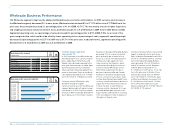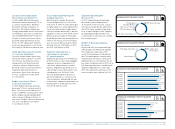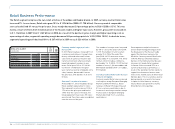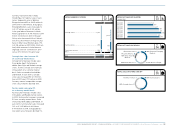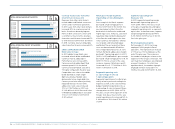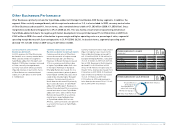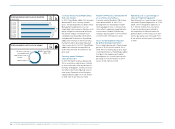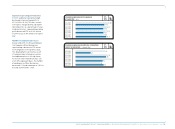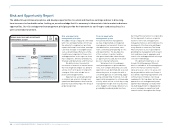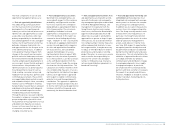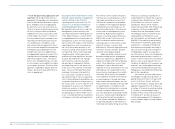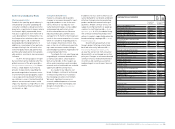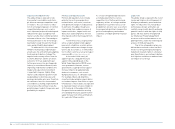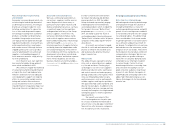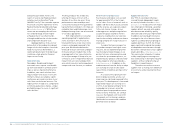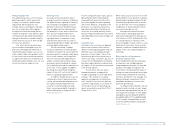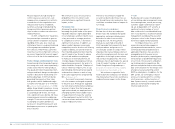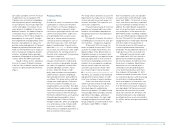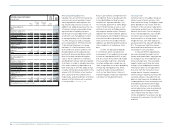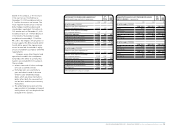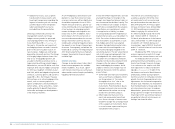Reebok 2009 Annual Report Download - page 146
Download and view the complete annual report
Please find page 146 of the 2009 Reebok annual report below. You can navigate through the pages in the report by either clicking on the pages listed below, or by using the keyword search tool below to find specific information within the annual report.
142 GROUP MANAGEMENT REPORT – FINANCIAL REVIEW Risk and Opportunity Report
Risk and opportunity aggregation and
reporting: The Group Finance function
aggregates Group-wide risks and reports
them to the Executive Board on a regular
basis. Individual risks are aggregated
based on the sum of all assessed risks
(sum of occurrence likelihood × potential
net loss), taking correlations between
individual risks into account. Risks with
a likely impact of at least € 1 million on
the forecasted full year contribution are
reported to the Group Finance function
on a monthly basis. In addition, risks
with a likely financial impact of € 5 mil-
lion or more are required to be reported
immediately upon identification to the
Group Finance function. Opportunities
are aggregated separately as part of the
strategic business planning, budgeting
and forecasting processes. The realisa-
tion of risks and opportunities can have
a critical impact on our ability to achieve
our strategic objectives. Therefore, Man-
agement is updated in regular business
reviews, but also through ad hoc discus-
sions as appropriate.
Description of the main features of the
internal control and risk management
system relating to the financial
reporting process pursuant to § 315
section 2 no. 5 German Commercial
Code (Handelsgesetzbuch – HGB)
We regard the internal control and risk
management system relating to the
consolidated financial reporting process
of the adidas Group as a system which
is embedded within the Group-wide risk
management system. The risk manage-
ment system with respect to the financial
reporting process aims at minimising
the risk of false representation in our
Group accounting and in external finan-
cial reporting. To this end, Group-wide
compliance with statutory provisions
and internal Group regulations must be
ensured. We regard the risk manage-
ment system as a process based on
the principle of segregation of duties,
encompassing various sub-processes
in the areas of Accounting, Controlling,
Taxes, Treasury, Planning, Reporting
and Legal, focusing on the identifica-
tion, assessment, treatment, monitor-
ing and reporting of financial reporting
risks. Clearly defined responsibilities are
assigned to each distinct sub-process in
the various areas. In a first step, the risk
management system serves to identify
and assess and also to limit and con-
trol risks identified in the consolidated
accounting process which might result
in our consolidated financial statements
not being in conformity with regulations.
The internal control system relating to
the financial accounting process serves
to provide reasonable assurance that
the financial statements are prepared
in compliance with regulations despite
identified financial reporting risks. To
ensure the effectiveness of the internal
control and risk management system,
the Internal Audit function regularly
reviews accounting-relevant processes.
Additionally, as part of the year-end
audit, the external auditor examines
selected aspects of the system, includ-
ing the IT systems, to assess their
effectiveness. Even with appropriate and
functional systems, however, absolute
certainty cannot be guaranteed.
adidas AG defines uniform consoli-
dated accounting policies and updates
these on a regular basis, dependent on
regulatory changes and internal develop-
ments. Clear regulations serve to limit
employees’ scope of discretion with
regard to inclusion and valuation of assets
and liabilities, thus reducing the risk of
inconsistent accounting practices within
the Group. These policies are available
to all employees involved in the financial
accounting process through the Group-
wide intranet. Material changes are com-
municated to the subsidiaries Group-wide
on a quarterly basis. Compliance with
the financial accounting rules is ensured
through continuous adherence to the
four-eyes principle in accounting-related
processes. Certain reporting obligations
and the extent thereof are mandatory
for the Group’s subsidiaries. Adherence
to reporting obligations and timelines is
monitored centrally by Group Accounting.
Financial accounting at subsidiaries is
conducted either locally by the respective
company or by a Shared Service Centre
that provides this service for several
subsidiaries. Most of the IT systems
used are based on SAP AFS. Some Group
companies use Navision-based ERP
software that was developed in-house.
The individual financial statements are
subsequently transferred into a cen-
tral consolidation system based on SAP
SEM-BCS. The regularity and reliability
of the financial statements prepared by
subsidiaries is reviewed at Group level
by Group Accounting and Controlling. If
necessary, the Group seeks the opinion
of independent experts to review busi-
ness transactions that occur infrequently
and cannot be processed as a matter of
routine. Controls within the consolidation
process, such as with regard to the con-
solidation of liabilities or of revenues and
expenses, are conducted both automati-
cally (system-based) and manually. Any
inadequacies are remedied and reported
back to the subsidiaries.
All financial systems used are pro-
tected against malpractice by means of
appropriate authorisation concepts and
access restrictions. Access authorisa-
tions are reviewed on a regular basis and
updated if required. The risk of data loss
or outage of financial-accounting-related
IT systems is minimised by Group IT
through central control and monitoring
of virtually all IT systems, by means of
centralised management of change pro-
cesses and with support through regular
data backups.


